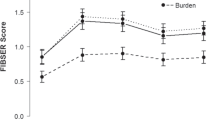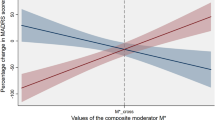Abstract
The purpose of this analysis was to explore the potential role of anxious MDD as a treatment predictor and moderator in major depressive disorder (MDD) using a large escitalopram clinical trial dataset. Individual patient-level data from 13 double-blinded, randomized, controlled trials in patients with MDD were pooled. Both univariate, last observation carried forward (LOCF) analyses and repeated measurements analyses without imputation (MMRM) were carried out for change in symptom scores, response and remission rates. Of 3,919 patients, 48.0% were classified as having anxious MDD depression (HAMD) somatization/anxiety subscale score ≥7 at baseline. Patients with anxious MDD were less likely to report symptom improvement on some outcome measures than patients without anxious MDD (predictor analysis). Specifically, the difference in response rates for patients with vs. patients without anxious MDD according to the MADRS (55.6% vs. 57.7%, respectively) was not statistically different. However, the difference in remission rates for patients with versus without anxious MDD according to the MADRS (37.6% vs. 44.1%, respectively) was statistically significant. Escitalopram was more effective than placebo, and as effective as the SSRIs and SNRIs, in the treatment of anxious MDD. The present analysis provides some evidence that the presence of an anxious MDD subtype is a predictor of poor response. There was no difference in the response to treatment of patients with or without anxious MDD to escitalopram, SSRIs, or SNRIs. The present analysis did not support the notion that SNRIs are more effective than escitalopram in the treatment of anxious MDD, nor was there evidence to support treatment moderating effects for anxious MDD.


Similar content being viewed by others
References
Trivedi MH, Rush AJ, Wisniewski SR, Nierenberg AA, Warden D, Ritz L, Norquist G, Howland RH, Lebowitz B, McGrath PJ, Shores-Wilson K, Biggs MM, Balasubramani GK, Fava M (2006) STAR*D study team. Evaluation of outcomes with citalopram for depression using measurement-based care in STAR*D: implications for clinical practice. Am J Psychiatry 163(1):28–40
Walsh BT, Seidman SN, Sysko R, Gould M (2002) Placebo response in studies of major depression: variable, substantial, and growing. JAMA 287(14):1840–1847
Melander H, Salmonson T, Abadie E, van Zwieten-Boot B (2008) A regulatory Apologia—a review of placebo-controlled studies in regulatory submissions of new-generation antidepressants. Eur Neuropsychopharmacol 18(9):623–627
Papakostas GI, Fava M (2009) Does the probability of receiving placebo influence clinical trial outcome? A meta-regression of double-blind, randomized clinical trials in MDD. Eur Neuropsychopharmacol 19(1):34–40
Papakostas GI, Fava M (2008) Predictors, moderators, and mediators (correlates) of treatment outcome in major depressive disorder. Dialogues Clin Neurosci 10:439–451
Kraemer HC, Wilson GT, Fairburn CG, Agras WS (2002) Mediators and moderators of treatment effects in randomized clinical trials. Arch Gen Psychiatry 59(10):877–883
Fava M, Uebelacker LA, Alpert JE, Nierenberg AA, Pava JA, Rosenbaum JF (1997) Major depressive subtypes and treatment response. Biol Psychiatry 42(7):568–576
Fava M, Martinez JM, Greist J, Marangell LB, Brown E, Chen L, Wohlreich MM (2007) The efficacy and tolerability of duloxetine in the treatment of anxious versus non-anxious depression: a post-hoc analysis of an open label outpatient study. Ann Clin Psychiatry 19(3):187–195
Fava M, Rush AJ, Alpert JE, Balasubramani GK, Wisniewski SR, Carmin CN, Biggs MM, Zisook S, Leuchter A, Howland R, Warden D, Trivedi MH (2008) Difference in treatment outcome in outpatients with anxious versus nonanxious depression: a STAR*D report. Am J Psychiatry 165(3):342–351
Rush AJ, Wisniewski SR, Warden D, Luther JF, Davis LL, Fava M, Nierenberg AA, Trivedi MH (2008) Selecting among second-step antidepressant medication monotherapies: predictive value of clinical, demographic, or first-step treatment features. Arch Gen Psychiatry 65(8):870–880
Howland RH, Wilson MG, Kornstein SG, Clayton AH, Trivedi MH, Wohlreich MM, Fava M (2008) Factors predicting reduced antidepressant response: experience with the SNRI duloxetine in patients with major depression. Ann Clin Psychiatry 20(4):209–218
Papakostas GI, McGrath P, Stewart J, Charles D, Chen Y, Mischoulon D, Dording C, Fava M (2008) Psychic and somatic anxiety symptoms as predictors of response to fluoxetine in major depressive disorder. Psychiatry Res 161(1):116–120
Souery D, Oswald P, Massat I, Bailer U, Bollen J, Demyttenaere K, Kasper S, Lecrubier Y, Montgomery S, Serretti A, Zohar J, Mendlewicz J, Group for the Study of Resistant Depression (2007) Clinical factors associated with treatment resistance in major depressive disorder: results from a European multicenter study. J Clin Psychiatry 68(7):1062–1070
Nelson JC, Delucchi K, Schneider LS (2009) Anxiety does not predict response to antidepressant treatment in late life depression: results of a meta-analysis. Int J Geriatr Psychiatry 24(5):539–544
Nelson JC (2010) Anxiety does not predict response to duloxetine in major depression: results of a pooled analysis of individual patient data from 11 placebo-controlled trials. Depress Anxiety 27(1):12–18
Papakostas GI, Stahl SM, Krishen A, Seifert CA, Tucker VL, Goodale EP, Fava M (2008) Efficacy of bupropion and the selective serotonin reuptake inhibitors in the treatment of major depressive disorder with high levels of anxiety (anxious depression): a pooled analysis of 10 studies. J Clin Psychiatry 69(8):1287–1292
Thase ME, Entsuah AR, Rudolph RL (2001) Remission rates during treatment with venlafaxine or selective serotonin reuptake inhibitors. Br J Psychiatry 178:234–241
Papakostas GI, Thase ME, Fava M, Nelson JC, Shelton RC (2007) Are antidepressant drugs that combine serotonergic and noradrenergic mechanisms of action more effective than the selective serotonin reuptake inhibitors in treating major depressive disorder? A meta-analysis of studies of newer agents. Biol Psychiatry 62(11):1217–1227
Hamilton MA (1960) A rating scale for depression. J Neurol Neurosurg Psychiatry 23:56–62
Burke WJ, Gergel I, Bose A (2002) Fixed-dose trial of the single isomer SSRI escitalopram in depressed outpatients. J Clin Psychiatry 63:331–336
Rapaport MH, Bos, A, Zheng H (2004) Escitalopram continuation treatment prevents relapse of depressive episodes. J Clin Psychiatry 65:44–49. See also: http://www.forestclinicaltrials.com/CTR/CTRController/CTRViewPdf?_file_id=scsr/SCSR_SCT-MD-02_final.pdf
Bose A, Li D, Gandhi C (2008) Escitalopram in the acute treatment of depressed patients aged 60 years or older. Am J Geriatr Psychiatry 16:14–20
Forest Laboratories (2001) Flexible dose comparison of the safety and efficacy of escitalopram and fluoxetine in the treatment of major depressive disorder. http://www.forestclinicaltrials.com/CTR/CTRController/CTRViewPdf?_file_id=scsr/SCSR_SCT-MD-16_final.pdf. Accessed 21 June 2007
Ninan PT, Ventura D, Wang J (2003) Escitalopram is effective and well tolerated in the treatment of severe depression. Poster presented at the Congress of the American Psychiatric Association, May 17–22, San Francisco, CA. See also: http://www.forestclinicaltrials.com/CTR/CTRController/CTRViewPdf?_file_id=scsr/SCSR_SCT-MD-26_final.pdf
Baldwin DS, Cooper JA, Huusom AK, Hindmarch I (2006) A double-blind, randomized, parallel-group, flexible-dose study to evaluate the tolerability, efficacy and effects of treatment discontinuation with escitalopram and paroxetine in patients with major depressive disorder. Int Clin Psychopharmacol 21:159–169
Boulenger JP, Huusom AKT, Florea I, Bækdal T, Sarchiapone M (2006) A comparative study of the efficacy of long-term treatment with escitalopram and paroxetine in severely depressed patients. Curr Med Res Opin 22:1331–1341
Ventura D, Armstrong EP, Skrepnek GH, Erder MH (2007) Escitalopram versus sertraline in the treatment of major depressive disorder: a randomized clinical trial. Curr Med Res Opin 23:245–250
Alexopoulos GS, Gordon J, Zhang D (2004) A placebo-controlled trial of escitalopram and sertraline in the treatment of major depressive disorder. Neuropsychopharmacology 29(suppl):S87. See also: http://www.forestclinicaltrials.com/CTR/CTRController/CTRViewPdf?_file_id=scsr/SCSR_SCT-MD-27_final.pdf
Montgomery SA, Huusom AKT, Bothmer J (2004) A randomised study comparing escitalopram with venlafaxine XR in primary care patients with major depressive disorder. Neuropsychobiology 50:57–64
Bielski RJ, Ventura D, Chang C-C (2004) A double-blind comparison of escitalopram with venlafaxine XR in the treatment of major depressive disorder. J Clin Psychiatry 65:1190–1196
Wade AG, Gembert K, Florea I (2007) A comparative study of the efficacy of acute and continuation treatment with escitalopram versus duloxetine in patients with major depressive disorder. Curr Med Res Opin 23:1605–1614
Khan A, Bose A, Alexopoulos GS, Gommoll C, Li D, Gandhi C (2007) Double-blind comparison of escitalopram and duloxetine in the acute treatment of major depressive disorder. Clin Drug Invest 27:481–492
Cleary P, Guy M (1977) Factor analysis of the Hamilton depression rating scale. Drugs Exp Clin Res 1:115–120
Montgomery SA, Åsberg M (1979) A new depression scale designed to be sensitive to change. Br J Psychiatry 134:382–389
Papakostas GI, Petersen T, Hughes ME, Nierenberg AA, Alpert JE, Fava M (2004) Anxiety and somatic symptoms as predictors of treatment-related adverse events in major depressive disorder. Psychiatry Res 126:287–290
Kennedy SH, Andersen HF, Thase ME (2009) Escitalopram in the treatment of major depressive disorder: a meta-analysis. Curr Med Res Opin 25(1):161–175
Fava M, Alpert JE, Carmin CN et al (2004) Clinical correlates and symptom patterns of anxious depression among patients with major depressive disorder in STAR*D. Psychol Med 34(7):1299–1308
Nierenberg AA, Greist JH, Mallinckrodt CH, Prakash A, Sambunaris A, Tollefson GD, Wohlreich MM (2007) Duloxetine versus escitalopram and placebo in the treatment of patients with major depressive disorder: onset of antidepressant action, a non-inferiority study. Curr Med Res Opin 23(2):401–416
Author information
Authors and Affiliations
Corresponding author
Rights and permissions
About this article
Cite this article
Papakostas, G.I., Larsen, K. Testing anxious depression as a predictor and moderator of symptom improvement in major depressive disorder during treatment with escitalopram. Eur Arch Psychiatry Clin Neurosci 261, 147–156 (2011). https://doi.org/10.1007/s00406-010-0149-3
Received:
Accepted:
Published:
Issue Date:
DOI: https://doi.org/10.1007/s00406-010-0149-3




